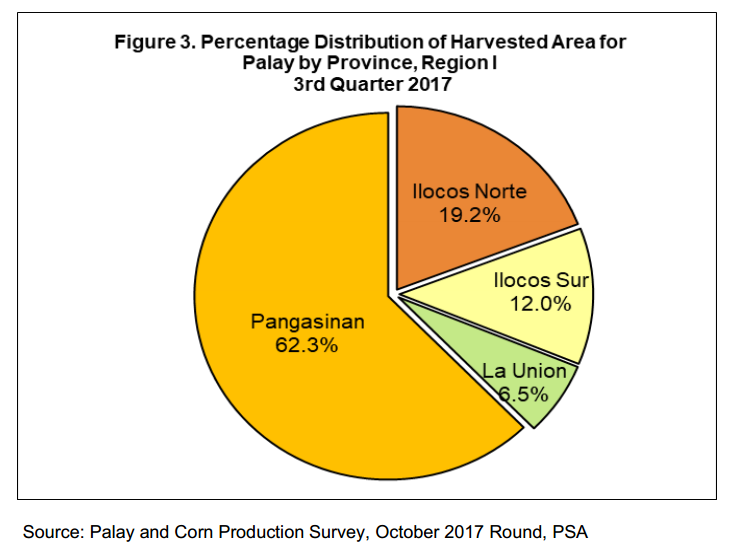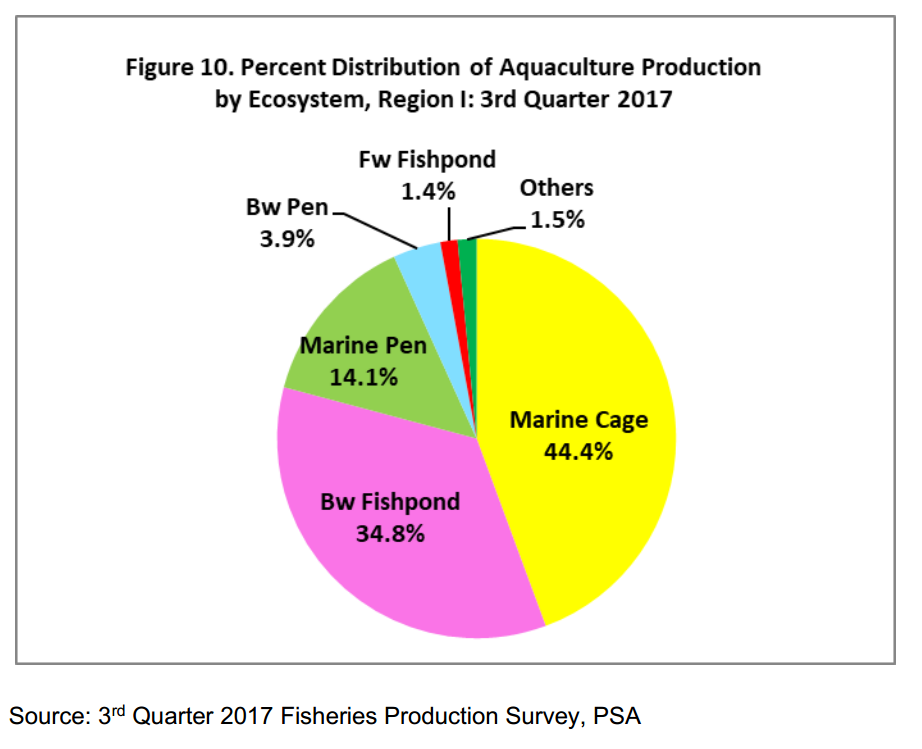Release Date :
Reference Number :
Issue No. 9, Series of 2017
(Results from the Fisheries Production Survey, 1st Quarter 2017)
The overall fisheries production in Region I went down by 5.5 percent in 1st quarter 2017. From the total output of 30,310 metric tons in 1st quarter 2016, it dropped to 28,630 metric tons this 1st quarter 2017. All the provinces posted decline in output.
The aquaculture sub-sector contributed 74.1 percent to the total fisheries production of Region I in 1st quarter 2017. Its production declined which pulled down the overall output of fisheries. Meanwhile, the commercial and municipal sub-sectors, which accounted 4.2 percent and 21.7 percent, respectively, both posted positive growth in output.

In terms of provincial distribution, the province of Pangasinan shared the bulk of production of about 83.8 percent in 1st quarter 2017. Its aquaculture sub-sector registered negative growth, while the commercial and municipal fisheries posted higher production as compared to its respective level in 1st quarter 2016. The total fishery output of the province decline by 2.6 percent from 24,634 metric tons to 23,997 metric tons.

The province of La Union registered lower overall fisheries production in 1st quarter 2017 as compared in its 1st quarter 2016 level. All its fisheries sub-sectors recorded lower production. Total fisheries output of the province was pegged at 1,788 metric tons, lower than the 2,351 metric tons recorded in the same period of 2016. La Union accounted 6.2 percent to the overall fisheries production of Region I in 1st quarter 2017.
The fisheries production of Ilocos Sur, which shared 5.5 percent to the total fisheries output of the region, registered decrement in 1st quarter 2017. Its production during the period was 1,577 metric tons, lower than the output of 1,820 metric tons in 1st quarter 2016. All the fisheries sub-sectors of the province posted decline in output.
The province of Ilocos Norte, which shared 4.4 percent to the total fisheries production of Region I, went down by 15.7 percent in 1st quarter 2017. Its output during the period was 1,268 metric tons, lower than the output in the same period of 2016 of 1,505 metric tons. The municipal sub-sector contributed to the overall negative growth in the fisheries output of the province.

Commercial Fisheries
The commercial fisheries volume of production in Region I increased by 14.5 percent in first quarter 2017. Its output was posted at 1,202 metric tons, higher than the output in the same period of 2016 of 1,049 metric tons contributed by the province of Pangasinan. More harvest from payaos and artificial reefs were noted. Also, there were increased number of fishing days due to good weather, presence of school of fish, efficiency of fishing gears used, and bigger sizes of catch. Meanwhile, the provinces of llocos Sur and La Union registered lower production. This can be attributed to lesser fishing days due to rough seas caused by Northeast monsoon or “amihan”, lesser number of boats as some were dry docked for repairs and maintenance, smaller sizes of catch, and absence of school of fish.
In terms of provincial shares, Pangasinan accounted for 76.8 percent of the region’s commercial fisheries volume of production, followed by La Union with 18.3 percent share, and Ilocos Sur, 5.0 percent share.

The top five major catch in the region during the 1st quarter 2017 were Skipjack, Rounscad, Indian mackerel, Frigate tuna, and Anchovies.

Municipal Fisheries
The overall municipal fisheries production of Region I in 1st quarter of 2017 went up by 0.6 percent. Overall production was posted at 6,223 metric tons, higher than the output in 1st quarter 2016 of 6,188 metric tons. Both the marine and inland municipal fisheries registered increases in output.
Marine Municipal

The province of Pangasinan contributed 59.2 percent of the region’s marine municipal fish catch in 1st quarter 2017, followed by Ilocos Sur with 20.7 percent share, Ilocos Norte with 14.1 percent share, and La Union with 6.0 percent. The dominant catch in marine municipal water of Region I during the period were Squid, Skipjack, Yellowfin tuna, Siganid, and Cavalla.

Inland Municipal Fisheries
Production of Inland Municipal Fisheries in Region I increased by 7.1 percent in 1st quarter  2017. Its output during the period was posted at 391 metric tons, higher than the output of 365 metric tons in 1st quarter 2016. All the provinces posted positive output, except La Union. Favorable water level, more fish shelters harvested, and bigger sizes of catch were the factors that could have contributed to the positive gains in output.
2017. Its output during the period was posted at 391 metric tons, higher than the output of 365 metric tons in 1st quarter 2016. All the provinces posted positive output, except La Union. Favorable water level, more fish shelters harvested, and bigger sizes of catch were the factors that could have contributed to the positive gains in output.

By province, Pangasinan ranked first in the volume of production of Inland municipal fisheries in 1st quarter 2017 with 41.3 percent share. It was followed by Ilocos Sur with 33.0 percent share, Ilocos Norte with 17.4 percent, and La Union with 8.3 percent. The top five major catch in the region during the period were Tilapia, Endeavor prawn, Freshwater goby, Carp, and Mullet.

Aquaculture

The province of Pangasinan shared the bulk of aquaculture production with 91.8 percent. By culture type, aquaculture in Region I was dominated by Marine cage which accounted for 54.5 percent of the total production.


Milkfish dominated the aquaculture production of Region I with a share of 87.1 percent. Its production in January-March 2017 was posted at 18,473 metric tons, lower than its output in the same quarter last year of 19,536 metric tons. All ecosystem showed decreases in milkfish production, except brackishwater pen. Smaller sizes of harvest due to change of water temperature from cold to hot, lower survival rate due to high water salinity, and movement of harvest to second quarter 2017 were the factors that contributed to the higher production.

Among the provinces of Region I, Pangasinan has the bulk of milkfish production in 1st quarter 2017. It shared 94.5 percent to the total production of the region. The rest were shared by the other three provinces.

TECHNICAL NOTES
-
The Fisheries Production Survey of the Philippine Statistics Authority (PSA) is divided into four (4) major fisheries surveys. These are the Quarterly Commercial Fisheries Survey (QCFS), Quarterly Municipal Fisheries Survey (QMFS), Quarterly Inland Fisheries Survey (QIFS) and Quarterly Aquaculture Survey (QAqS). The commercial and municipal fisheries surveys aim to provide quarterly data on volume and value of fish production by species, by region and by province. The aquaculture survey is intended to generate quarterly data on volume and value of cultured species by environment, by type of aquafarm, by region and by province.
-
· Concepts and Definitions:
Aquaculture – fishery operation involving all forms of raising and culturing of fish and other fishery species in marine, brackish and fresh water environment. Examples are fishponds, fish pens, fish cages, mussel, oyster, seaweed farms and hatcheries.
Aquafarm – the farming facilities used in the culture or propagation of aquatic species including fish, mollusk, crustaceans and aquatic plants for purposes of rearing to enhance production.
Brackishwater – mixture of seawater and freshwater with salinity that varies with the tide.Example are estuaries, mangroves and mouths of rivers where seawater enters during high tide.
Commercial Fishing – the catching of fish with the use of fishing boats with a capacity of more than three (3) gross tons for trade, business or profit beyond subsistence or sports fishing.
Fisheries – all activities relating to the act or business of fishing, culturing, preserving, processing, marketing, developing, conserving and managing aquatic resources and the fishery areas including the privilege to fish or take aquatic resources thereof (RA 8550).
Fisheries Sector – the sector engaged in the production, growing, harvesting, processing, marketing, developing, conserving and managing of aquatic resources and fishing areas.
Fish Cage – stationary or floating fish enclosure made of synthetic net wire/bamboo screen or other materials set in the form of inverted mosquito net (“hapa” type) with or without cover with all sides either tied to poles staked to the water bottom or with anchored floats for aquaculture purposes.
Fishing Gear – any instrument or device and its accessories utilized in taking fish and other fishery species.
Fishing Grounds – areas in any body of water where fish and other aquatic resources congregate and become target of capture.
Fish Pen – an artificial enclosure constructed within a body of water for culturing fish and fishery/ aquatic resources made up of bamboo poles closely arranged in an enclosure with wooden materials, screen or nylon netting to prevent escape of fish.
Fishpond – a body of water (artificial or natural) where fish and other aquatic products are cultured, raised or cultivated under controlled conditions. This is a land-based type of aquafarm. Note that the setting-up of fish cages in ponds does not make the operation of fish cage and at the same time a fishpond.
Freshwater – water without salt or marine origin, such as generally found in lakes, rivers, canals, dams, reservoirs, paddy fields and swamps.
Inland Municipal Fishing – the catching of fish, crustaceans, mollusks and all other aquatic animals and plants in inland water like lakes, rivers, dams, marshes, etc. using simple gears and fishing boats some of which are non-motorized with a capacity of three (3) gross tons or less; or fishing not requiring the use of fishing boats.
Landing Center – place where the fish catch and other aquatic products are unloaded and traded.
Municipal Fishing – covers fishing operation carried out with or without the use of a boat weighing three (3) gross tons or less.

